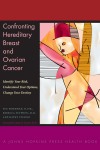The Doctor Is In is an occasional series where JHU Press authors discuss the latest developments and news in health and medicine.
Guest post by Kathy Steligo
As a woman who has had lumpectomy on both breasts, I thank my lucky stars for that simple yet effective operation. But a new study published recently in the Journal of the American Medical Association brings up a worrisome issue: medical guidelines dictate when lumpectomy should be an option, but don’t describe how much tissue beyond the tumor should be removed.
Surgeons remove a segment of tissue around the tumor in an effort to get “clear margins,” without any cancer cells. Without medical guidelines dictating how much is too little and how much is too much, surgeons decide on the amount of tissue to be removed based on their own insight and intuition. This study showed, however, that in some cases, those qualities fall short and the patient pays the price.
This research shows that some women who need more surgery aren’t getting it, while others are having unneeded surgeries. . . . It is an indication of the need for some level of surgical guidelines regarding lumpectomy.
Reviewing the records of 2,206 lumpectomy patients at four hospitals in different areas of the country, researchers found that about 23 percent of the women had a repeat lumpectomy, even though about half of them had clear pathology reports. What patient benefit did those second surgeries serve? Even more troubling, 14 percent of the women studied were found to have residual breast cancer cells after lumpectomy, yet they did not return to the OR—the reasons for this weren’t identified. The rates of repeat surgery also varied wildly among surgeons, ranging from zero to more than 70 percent. What would validate one surgeon having do-overs on almost three-quarters of his or her patients?
Every breast cancer case is different, so it’s understandable that lumpectomies might not be performed exactly the same way for all women. But the study results underscore one fact: presented with the same lumpectomy, surgeons have differing opinions of how much tissue should be removed “to be safe.” Some like to err on the side of caution, removing a wide margin of tissue, while others take a more conservative approach, trying to remove cancerous tissue while preserving the shape and volume of the breast as much as possible. Most importantly, this research shows that some women who need more surgery aren’t getting it, while others are having unneeded surgeries.
It’s not clear whether the findings of this one study would hold up if all lumpectomies were subjected to the same scrutiny, but it is an indication of the need for some level of surgical guidelines regarding lumpectomy. Hopefully this will motivate surgeons and the appropriate health officials to do what is needed—recognize that each patient case is different, but establish guidelines that help surgeons become more effective and ensure that fewer women experience the frustration and anguish of a repeat lumpectomy.
In the meantime, what should women do if they’re facing a lumpectomy? Be your own advocate: ask questions, research your options, and get a second opinion before any surgery. Insurance usually pays for getting a second opinion; it takes just a bit of time and will be well worth the effort.
 Kathy Steligo is co-author of Confronting Hereditary Breast and Ovarian Cancer, published by JHU Press. She is also the author of The Breast Reconstruction Guidebook, the third edition of which is forthcoming from JHU Press.
Kathy Steligo is co-author of Confronting Hereditary Breast and Ovarian Cancer, published by JHU Press. She is also the author of The Breast Reconstruction Guidebook, the third edition of which is forthcoming from JHU Press.
The information provided in this blog post is not meant to substitute for medical advice or care provided by a physician, and testing and treatment should not be based solely on its contents. Instead, treatment must be developed in a dialogue between the individual and his or her physician. This post has been written to help with that dialogue. The services of a competent medical professional should be obtained whenever medical advice is needed.

